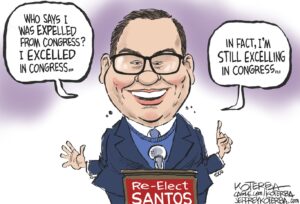Education Department Bureaucracy Keeps Disabled Borrowers in Debt
Under federal law, borrowers who develop lasting disabilities after taking out federal student loans are entitled to have their debts forgiven. The system was meant to spare former students who become disabled from a lifetime of spiraling debt. But the process of discharging the loans of disabled borrowers is broken.By Sasha Chavkin, Cezary Podkul, Jeannette Neumann and Ben Protess
This article is a collaboration among ProPublica and the Center for Public Integrity, which are independent nonprofit investigative newsrooms; and the Stabile Center for Investigative Journalism, at Columbia University.
It was co-published with the Chronicle of Higher Education.
Tina Brooks can’t sit or stand for more than half an hour before the pain in her lower back becomes intolerable. She suffers severe headaches and memory loss, and she has lost most of the vision in her left eye. Five doctors and a judge from the Social Security Administration have all determined that she is fully disabled and unable to work.
A former police officer and mother of two, Brooks fractured a vertebra in her back, damaged three others in her neck, and suffered a concussion when she fell 15 feet down a steep rock quarry while training for bicycle patrol. But even though Social Security approved her disability claim, she has been mired for more than five years in an unsuccessful struggle to persuade the Department of Education to accept that she is too disabled to work again—and to forgive the $43,000 that she borrowed in federal student loans.
“I’m a cop, and I know how to fill out paperwork,” Brooks says. “But when you’re trying to comply with people and they’re not telling you the rules, I might as well beat my head on the wall.”
Under federal law, borrowers who develop severe and lasting disabilities after taking out federal student loans are entitled to have their debts forgiven. The system was meant to be compassionate: to spare former students who become disabled from a lifetime of ruined credit, garnished benefits, and spiraling debt. But an investigation by ProPublica and the Center for Public Integrity has found that the process of discharging the loans of disabled borrowers is broken.
These borrowers, whose ailments often make it hard for them to navigate a complex bureaucracy, confront a byzantine system that has resulted in many applicants’ being rejected for unclear reasons, and has led many others to simply give up. Despite demands for improvement from Congress, the courts, and its own internal watchdog, the Education Department has repeatedly failed to heed basic recommendations for fixing the process.
An unpublished internal report by the federal student-aid ombudsman in 2009, obtained through a public-records request, urged the Education Department to resolve “fundamental deficiencies in the disability discharge process. It proposed changes to address the problems of “no written medical standards for determining disability,” “no formal appeals process” for denials, and “undue burden and costs” on borrowers, who must obtain required medical forms from their doctors at their own time and expense. The ombudsman has twice recommended that the department consider scrapping its review altogether—and instead contract the decisions out to the Social Security Administration or other agencies with “mature and proven processes” for evaluating disability.
None of these recommendations has been followed.
The department has been more responsive to reforms ordered by Congress and the courts, but applicants have seen little change. Congress passed a law in 2008 creating an expedited loan-discharge process for veterans and easing the standard for discharge, from a full disability that is either indefinite or terminal to, instead, five years of full disability. In 2009 a federal court in Missouri found that the program’s communication with borrowers was so poor that it was unconstitutional, violating applicants’ due-process rights.
In 2010 the department put into effect changes including the facilitated process for veterans and the relaxed discharge standard ordered by Congress, along with a new online system for handling submissions that allows borrowers to check their application status on the Web. It also provides more informative correspondence and a more detailed application form for borrowers, steps proposed by the ombudsman and an internal department task force.
“We know that there have been problems and shortcomings with the system and the process for some time,” says a department spokesman, Justin Hamilton. “We have been working to remedy those, including the development and implementation of a new system to better serve the needs of this community.”
But advocates who work with student borrowers say they have yet to see those reforms reflected in the experiences of their clients.
“They’ve made some improvements now, to their credit, but I think the actual, on-the-ground practice of getting information to borrowers is still the same,” says Deanne Loonin, an attorney with the National Consumer Law Center and director of its Student Loan Borrower Assistance Program. “We’re still seeing the same kind of problems we’ve seen for a long time.”
Rejections Untallied
It is unclear how many borrowers seeking loan discharges are needlessly turned away, mostly because the department has released only limited data on the program. The statistics it provided show that from 2007 to 2009, the department received 174,718 such applications. About 45,000 were rejected or remained unresolved, but the data did not distinguish between the two.
The department did not provide reasons for its denials, or track how many borrowers were rejected during other stages of the lengthy assessment process.
For instance, borrowers are often rejected during an initial review by private lenders and nonprofit guarantors that are subsidized by the government. Those rejections are neither monitored nor subject to appeal within the department, despite recommendations by the ombudsman to either make the reviews more accountable or eliminate them altogether.
More than three-quarters of outstanding student debt is held by the federal government, according to statistics compiled by Mark Kantrowitz, an author and consultant on student financial aid. In the strict world of student loans, even bankruptcy is usually not sufficient reason for debts to be forgiven, and most private loans cannot be discharged for disability regardless of a borrower’s condition.
The Education Department says it has to set its own high bar for debt discharge — and not accept disability findings from Social Security — because of the tough standard set out for it by Congress. Other agencies can always cut off benefits if a patient recovers, it says, while the decision to discharge a loan is permanent.
The department also says that it must be vigilant in protecting taxpayer dollars against fraudulent applications to cancel loans. Until 2000 the department accepted discharges made by government-subsidized lenders. It added its own review only after an audit found that some borrowers were earning wages again after receiving disability discharges.
But experts say the current system often fails to provide disabled borrowers with the relief they are legally entitled to receive.
“It certainly would be a more ethical method, and it would also be more efficient to have the student-loan discharges rely on Social Security Administration determinations instead of having a separate duplicative process,” Kantrowitz says. The disability review by Social Security details the conditions that are eligible, explains how those conditions should be documented, includes a formal process for appeal, and pays for applicants to undergo evaluations by doctors.
Policewoman’s Frustration
Tina Brooks’s accident occurred during police training for bicycle patrol in January 2000, when she fell from her bicycle on an off-road course and tumbled 15 feet down the walls of a rock quarry. Despite years of physical therapy and a spinal-fusion operation, the back pain that resulted from her injuries got so bad that she couldn’t sit, stand, or walk for more than a few minutes at a time.
In 2004 her doctors told her that her condition was permanent. She applied to Social Security for disability benefits, and in 2006 a Social Security judge ruled that she was fully disabled. Brooks thought she was done proving her disability to the government.
But canceling her student debt turned out to be far harder.
Her application to discharge her student debt had been approved by the lender and the guarantor in 2005. But soon after her disability approval from Social Security, Brooks received a letter saying that she needed to resume her payments on her student debt. It came from Affiliated Computer Services (ACS), a contractor hired by the Education Department to provide customer service and manage information for programs including the disability discharge review.
It turned out that the Education Department had rejected Brooks’s application — but she had not received notice when the decision was made, and she had not been provided with a reason for the denial.
Findings by the Government Accountability Office and meeting minutes from the Education Department show that officials repeatedly criticized ACS’s performance. In 2010 the department hired a new contractor, Nelnet, to handle disability discharges. ACS says borrowers received “a consistently high level of service” during its tenure. Nelnet says its communications and application processes are “intuitive, clear, compliant, and up to the department’s high standards.”)
In July 2007, on the advice of a customer service agent from the department, Brooks submitted her entire application again. This time, when she repeatedly contacted the department about her application, it told her that she had not provided enough information. Because the program has no written medical standards, no one could tell her what information she needed to provide.
“It’s so frustrating to not understand what they’re looking for,” Brooks says. “It’s like taking a college exam and it’s blank, but you have to fill in the answers.”
She turned to the federal student-aid ombudsman for help but was told that the department wouldn’t change its decision. “Current regulations do not provide for appeal of decision made by the Department,” the ombudsman wrote to her in August 2008.
So far, Brooks has been able to receive temporary deferments on her payments on the basis of economic hardship, through a separate process that is unrelated to the disability review. But the deferments are scheduled to run out this year, and she says she has no way of paying off her loans. More than $4,000 in interest has accrued during the years Brooks has struggled with the department, swelling her debt to $47,500. Citing legal obligations to protect borrowers’ privacy, the department declines to comment on her case.
Anxious to avoid default, Brooks applied again in December 2010 to discharge her debt. Her application is under review, and she has been advised to expect a decision shortly.
Brooks says that she hasn’t seen any improvements in the program, but that she has to keep on trying: “I don’t have any other choice.”
Disability Payments Garnished
An unpublished 2008 report by the federal student aid ombudsman gave a sense of just how common such failures of communication and bureaucratic obstacles are.
The report analyzed 106 borrower complaints related to disability discharge and found that in 36 percent of those cases, borrowers’ discharge applications had been rejected not because of any questions about their condition, but because their doctors had not adequately responded to requests for additional documentation.
Yet the borrowers were not told that. Instead, they received letters saying only that they were being denied because of “medical review failure.” In 23 percent of the cases reviewed in the report, the borrower had already been determined by Social Security to be disabled.
In some cases, borrowers see even their Social Security disability benefits garnished by the federal government to pay down their student loans.
Scott Creighton, a former carpenter and draftsman living in Tampa, Fla., was declared disabled by Social Security in September 2009. Three years before, he had suffered a pulmonary embolism — a blood clot traveled from his leg to block the main artery of his lung — that left him unable to work a full day or repay his federal student loans.
“The claimant has the following severe impairments: deep vein thrombosis, chronic obstructive pulmonary disease, and depression,” ruled Social Security Judge Christopher Messina. “Considering the claimant’s age, education, work experience, and residual functional capacity, there are no jobs that exist in significant numbers in the national economy that the claimant can perform.”
The Education Department is still collecting on Creighton’s student loans. Soon after the judge’s decision, Creighton began receiving calls from Enterprise Recovery Systems, a debt collector acting on behalf of the department. On the advice of a customer service agent, he requested a disability discharge of his debt and sent Enterprise his medical records and the Social Security judge’s decision.
In November 2009, Creighton received a rejection letter from Enterprise. It said he had failed to prove that his condition had not existed when he took out his loans, even though he obtained the last of his federal loans in 1993, more than a decade before the embolism.
Enterprise told Creighton he could apply to the Education Department to forgive his loans if he would never be able to work again. But although his condition is permanent, he still hopes to work one day. Enterprise never mentioned the law easing the standard for discharge to five years of disability, Creighton says, and he decided not to submit such an application to the department.
So, for almost a year, the Education Department has been garnishing 15 percent of Creighton’s monthly disability checks from Social Security to pay off his student loans. The department takes $170 out of his monthly benefit of $1,135, reducing it to $965.
“One hundred and seventy dollars may not seem like a lot, but I make less than a thousand a month on fixed income,” Creighton says. “That has a huge effect on me.”
Interactive timeline: Calls for Reform and One Borrower2019s Struggle
Your support matters…Independent journalism is under threat and overshadowed by heavily funded mainstream media.
You can help level the playing field. Become a member.
Your tax-deductible contribution keeps us digging beneath the headlines to give you thought-provoking, investigative reporting and analysis that unearths what's really happening- without compromise.
Give today to support our courageous, independent journalists.









You need to be a supporter to comment.
There are currently no responses to this article.
Be the first to respond.